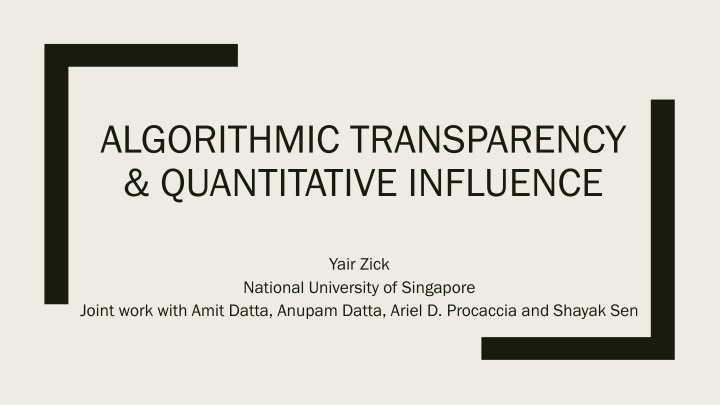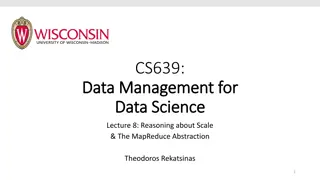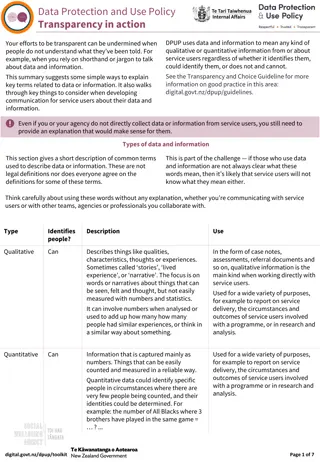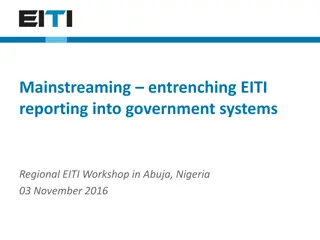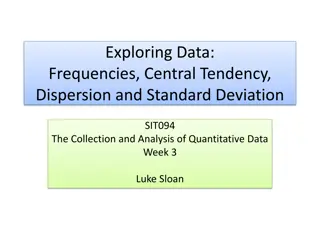Algorithmic Transparency & Quantitative Influence
This research explores the impact of algorithmic decision-making in various sectors such as health, education, finance, and media. It discusses the challenges of black-box decision-makers and the importance of algorithmic transparency. The work emphasizes the need for explaining black-box models to stakeholders and quantifying feature influence in datasets. Additionally, it highlights the risks associated with personalized transparency reports and the significance of axiomatic feature influence measures. The study also introduces the concept of quantitative input influence to support transparency in decision-making processes.
Download Presentation

Please find below an Image/Link to download the presentation.
The content on the website is provided AS IS for your information and personal use only. It may not be sold, licensed, or shared on other websites without obtaining consent from the author.If you encounter any issues during the download, it is possible that the publisher has removed the file from their server.
You are allowed to download the files provided on this website for personal or commercial use, subject to the condition that they are used lawfully. All files are the property of their respective owners.
The content on the website is provided AS IS for your information and personal use only. It may not be sold, licensed, or shared on other websites without obtaining consent from the author.
E N D
Presentation Transcript
ALGORITHMIC TRANSPARENCY & QUANTITATIVE INFLUENCE Yair Zick National University of Singapore Joint work with Amit Datta, Anupam Datta, Ariel D. Procaccia and Shayak Sen
Black-Box Decision Makers are Everywhere Health Education Finance Media Insurance discounts for data Determining loan eligibility course assignments Personalized Ads data-driven insurance policies Streaming and course allocation Credit Scores News & Social Media
Explaining Black-Box Decision Makers Stakeholders have a right to explanation but algorithms are often black boxes : intellectual property inherently complex
Quantitative Feature Influence (Datta, Datta, Proccacia and Zick, IJCAI 2015; Datta, Sen and Zick, IEEE S&P 2016) We are given a dataset (a set of labelled data points) How important was feature ? in the decision for An individual? A group (e.g. ethnic minorities, gender groups)? In general? Numerical measures of feature importance in black-box settings: algorithmic transparency algorithmic transparency
Privacy Privacy Algorithmic Algorithmic Transparency Transparency Integrity Integrity Fairness Fairness 5
Personalized Transparency Report An individual was deemed worthy of arrest Birth Year 1984 Drug History None Smoking History None Census Region West Race Black Gender Male Evidence of racial discrimination Illustrates the dangers of the black-box use of machine learning
Axiomatic Feature Influence (Datta, Datta, Procaccia and Zick, IJCAI 2015) How should an influence measure behave? What properties do we want our measure to have? A common approach in game theory: provably fair revenue division methods. Influence as a resource that needs to be divided. There exist unique influence measures satisfying certain natural properties.
Quantitative Input Influence (QII) (Datta, Sen and Zick, IEEE S&P 2016) Supports a general class of transparency queries Deals with correlated inputs Computes joint and marginal influence a causal measure Breaks correlations via randomized interventions. parametric in a quantity of interest From individual to group influence uses game theoretic aggregation measures
QII for Individual Outcomes ?? Inputs ? ?1,?2, ,??, ,?? ? ??? ?1,?2, ,??, ,?? ? ? Classifier Quantity Measured Pr ? ? = 1 ? = ?] Pr ? ? ??? = 1 ? = ?] Randomized intervention on feature ? breaks correlations: replace ?? with an independent random sample ??.
Quantity of Interest Outcome of an individual Pr ? ? = ?(?0) ? = ?0] Outcomes of a group of individuals Pr ? ? = 1 ? is female] Disparity between group outcomes Pr ? ? = 1 ? is male] Pr ? ? = 1 ? is female]
QII: Definition ??? = ? ? ?(? ???)
Joint and Marginal Influence ????? 3 Classifier Decision ??? 50 ?????? 50? Interventions on individual inputs commonly have no effect!
Resampled features in ? Set QII Inputs ? ?1,?2, ,??, ,?? ? ??? ?1,?2, ,??, ,?? ? ? Classifier Quantity Measured ?(?) ? ? ??? Randomized intervention on a set of features ? ? = ? ? ?(? ???)
The marginal importance of ? ??? = ? ? ? ? ? = ? ? ??? ?(? ? ??? {?}) How much impact does ? have given that we have already intervened on ?? Measure average marginal influence of ? How should we aggregate ??(?)? Well studied in economics! The Shapley value, the Banzhaf index 1 ? ? The only value to satisfy certain desirable properties! ??= ??? ? ?
Personalized Transparency Report An individual was deemed worthy of arrest Birth Year 1984 Drug History None Smoking History None Census Region West Race Black Gender Male Evidence of racial discrimination Illustrates the dangers of the black-box use of machine learning
Summary General transparency queries Average Marginal Influence Correlated inputs Additional Results Use game- theoretic notions of average marginal influence Parametric in a quantity of interest Most measures can be efficiently approximated Define a causal measure QII measures can be made differentially private cheaply Axiomatically justified measures Robust to broad range of queries
